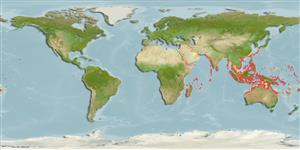>
Ovalentaria/misc (Various families in series Ovalentaria) >
Pomacentridae (Damselfishes) > Pomacentrinae
Etymology: Amblyglyphidodon: Greek, amblys = darkness + Greek, glyphis = carved + Greek, odous = teeth (Ref. 45335).
More on author: Bleeker.
Environment: milieu / Zona climática / intervalo de profundidade / distribution range
Ecologia
marinhas associadas(os) a recifes; não migratória; intervalo de profundidade 2 - 45 m (Ref. 7247). Tropical; 35°N - 24°S, 32°E - 172°W
Indo-West Pacific: from the Eastern Indian Ocean; north to Ryukyu Is.; south to Indonesia, including Western Australia up to the Caroline and Marshall Is.
Tamanho / Peso / Idade
Maturidade: Lm ? range ? - ? cm
Max length : 14.4 cm TL macho/indeterminado; (Ref. 30504)
Descrição suscinta
Chaves de identificação | Morfologia | Morfometria
Espinhos dorsais (total) : 13; Raios dorsais (total) : 12 - 13; Espinhos anais: 2; Raios anais : 12 - 14. This species is distinguished by the following characters: D XII-XIII,12-13 (usually XIII,12); A II,12-14 (often II,13); pectoral rays 16-17; lateral line tubed scales 14-17; gill rakers total, 25-29; body depth is 1.5-1.8 in SL; colouration, silvery grey with paler scale centers and yellow belly, the anterior half of anal fin and anterior margin of soft dorsal fin and the upper and lower margins of caudal fin is blackish; upper pectoral fin base with a distinct wedge-shaped black mark (Ref. 82240).
Body shape (shape guide): short and / or deep; Cross section: compressed.
Adults inhabit lagoons, reef passages, and the outer reef slopes as solitary individuals or in small groups. Feed on copepods, amphipods, mysids, fish eggs, crustacean larvae, and a small portion of algae (Ref. 7247). Oviparous, distinct pairing during breeding (Ref. 205). Eggs are demersal and adhere to the substrate (Ref. 205). Males guard and aerate the eggs (Ref. 205).
Ciclo de vida ou comportamento de acasalamento
Maturidade | Reprodução | Desova | Ovos | Fecundidade | Larvas
Oviparous, distinct pairing during breeding (Ref. 205). Eggs are demersal and adhere to the substrate (Ref. 205). Males guard and aerate the eggs (Ref. 205).
Allen, G.R. and J.E. Randall, 2002. A review of the leucogaster species complex of the Indo-Pacific pomacentrid genus Amblyglyphidodon, with descriptions of two new species. aqua, J. Ichthyol. Aquat. Biol. 5(4):139-152. (Ref. 82240)
Status na Lista Vermelha da UICN (Ref. 130435: Version 2025-1)
Ameaça para os humanos
Harmless
Uso pelos humanos
Pescarias: pouco comercial; Aquário: Espécies comerciais
Ferramentas
Relatórios especiais
Baixar XML
Fontes da internet
Estimates based on models
Preferred temperature (Ref.
123201): 24.9 - 29, mean 27.9 °C (based on 666 cells).
Índice de diversidade filogenética (Ref.
82804): PD
50 = 0.5005 [Uniqueness, from 0.5 = low to 2.0 = high].
Bayesian length-weight: a=0.01995 (0.01150 - 0.03460), b=2.95 (2.80 - 3.10), in cm total length, based on LWR estimates for this species & (Sub)family-body (Ref.
93245).
Nível Trófico (Ref.
69278): 3.4 ±0.39 se; based on food items.
Resiliência (Ref.
120179): Elevada, tempo mínimo de duplicação da população menor que 15 meses (Preliminary K or Fecundity.).
Fishing Vulnerability (Ref.
59153): Low vulnerability (10 of 100).
🛈
Nutrients (Ref.
124155): Calcium = 95.7 [46.9, 147.0] mg/100g; Iron = 0.78 [0.46, 1.29] mg/100g; Protein = 18.3 [17.1, 19.4] %; Omega3 = 0.123 [0.073, 0.207] g/100g; Selenium = 25.1 [12.9, 48.9] μg/100g; VitaminA = 142 [42, 461] μg/100g; Zinc = 1.33 [0.88, 1.92] mg/100g (wet weight);
